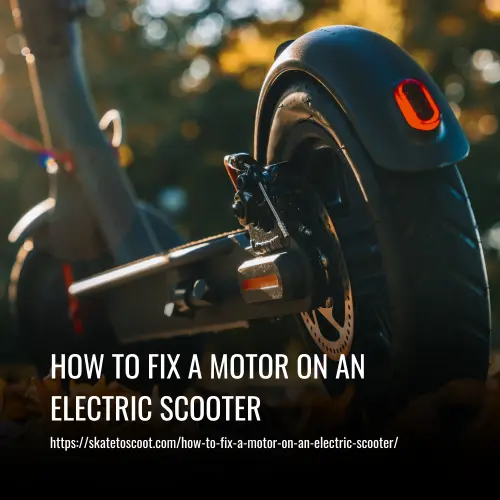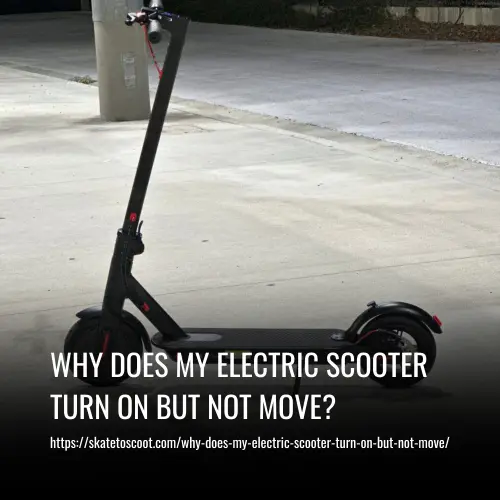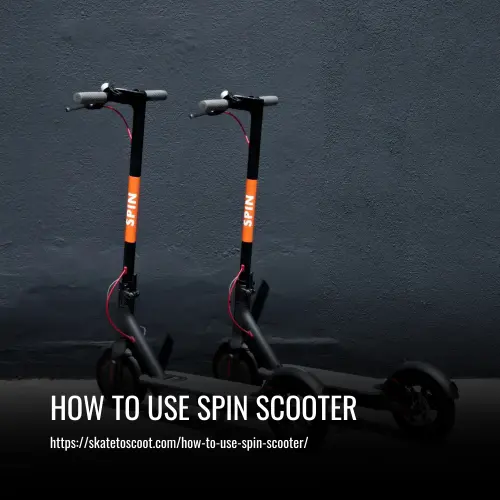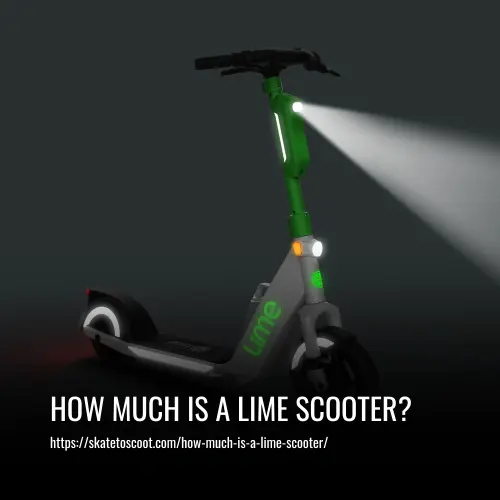As an Amazon Associate we earn from qualifying purchases.
Electric scooters have gained popularity as an eco-friendly and convenient mode of transportation. However, like any other mechanical device, electric scooters may encounter motor issues over time. Understanding how to fix these motor problems can save you time and money, allowing you to enjoy a smooth and reliable ride.
In this article, we will explore common motor issues that electric scooters encounter, along with step-by-step instructions on fixing them. From loose connections and faulty motors to defective speed controllers and battery problems, we will provide practical solutions to get your scooter up and running again.

How to Fix a Motor on an Electric Scooter: Step-by-Step Guide
When your electric scooter’s motor fails to start, it can be frustrating. However, there are several steps you can take to troubleshoot and fix the issue. Here’s a guide on how to fix a motor on an electric scooter:
1. Switch on the Electric Scooter
Start by turning on the electric scooter. If it doesn’t start, try kick-starting it if your scooter has kick-start motors. Push it forward with one foot and use the other foot to stand on the deck. If kick-starting doesn’t work or the scooter turns on properly, move on to the next step.
2. Inspect the Motor
Thoroughly inspect the motor for loose wires, connectors, or disconnected wires. If you’ve experienced bumpy rides before, it’s possible that the wiring system may have loosened. Gently tighten each component into its correct place and check for any melted or burnt motor components. If you find any, the motor may have overheated and the insulation may have worn off, necessitating motor replacement.
3. Check the Charger and Battery
Inspect the charger for a working indicator light. If the light blinks or turns off quickly, it may be defective. Use a voltmeter to check if you’re getting the correct voltage output. Additionally, check the battery for any damage. Riding in harsh conditions or on bumpy roads can cause battery issues. A faulty battery can result in a lack of power for the motor.
4. Check the Circuit Breaker or Fuse
Determine if your electric scooter uses a circuit breaker or a fuse. If either of these is burnt, the motor will not work. Use a multimeter to check if the circuit breaker or fuse is functioning. If it’s not, you’ll need to replace it.
5. Inspect the Controller
Check for any signs of a defective speed controller, such as roasted wires or wire connectors. If you detect a burnt smell or other signs of damage, the controller may need to be replaced. Ensure that all electrical components around the controller are functioning properly.
6. Check the Brake Lever Switch
A worn-out brake lever switch can cause the motor to malfunction. If the switch is damaged, it may not send the necessary signals to the speed controller. Check the switch and replace it if needed to prevent long-term motor damage.
7. Inspect the throttle
A malfunctioning throttle can prevent the motor from working. Test the throttle using a multimeter and a DC power source. If the voltage reading is lower than 4.5V, the throttle is defective and needs to be replaced.
8. Check the Bearings
Inspect the motor bearings for smooth operation. If they are worn out, they can cause the motor to become jammed. Replace the bearings after approximately 3000 miles to ensure the motor functions properly.
By following these steps you can fix the motor on your electric scooter and get back to enjoying your rides. If you’re unsure or uncomfortable with the process, it’s always best to seek professional assistance.
How Does an Electric Scooter Motor Work
Electric scooter motors are responsible for transmitting power from the battery to the scooter’s wheels, enabling it to move. There are various types of motors used in electric scooters, including electric motors and hub motors. These motors are typically installed on the front or rear wheel and do not alter the overall design or structure of the scooter.
Hub motors, a common type of electric scooter motor, can be further categorized into gearless hub motors and geared hub motors. Gearless hub motors are larger and more efficient, delivering substantial power and rotation to the scooter. On the other hand, geared hub motors are smaller, lighter, and provide a better range.
Another classification of electric scooter motors is brushed and brushless motors. Brushed motors are sturdy and durable, capable of withstanding higher driving pressure. However, they are less powerful and efficient, with more moving parts. On the other hand, brushless motors are more powerful and transmit more power and torque to the scooter. However, they may be less reliable in adverse conditions.
Common Problems Of Motor On An Electric Scooter
The motor is a vital component of an electric scooter, responsible for propelling the vehicle forward. However, like any mechanical part, it can experience issues over time. Here we will discuss some common problems with electric scooter motors.
1. Loose or Damaged Connections
One frequent issue with electric scooter motors is loose or damaged connections between the motor and the controller. If you find any loose or frayed wires, secure and repair them as necessary. In some cases, replacing the wire connectors may be required.
2. Worn or Damaged Motor
Another potential problem is a worn or damaged motor. This can occur due to wear and tear, extreme riding activities, or steep inclines. If you notice any signs of damage, such as strange noises, reduced power, or the motor not working at all, it may be necessary to replace the motor.
How to Test an Electric Scooter Motor for Issues
When your electric scooter fails to start, there could be several reasons for it, ranging from simple wire disconnections to more significant motor issues. To pinpoint the problem and troubleshoot your electric scooter motor, follow these steps:
1. Check the Cables
Loose cables are a common culprit behind a failing electric scooter motor. Examine the wiring carefully and gently pull on the wires with added tension. If any wires come loose, reattach them securely.
2. Look for Burned Wires
Overloading can cause electric scooter wires to get burned. Check the controller, motor, and other electrical components for any burnt wires. If you detect a burnt smell or notice melted plastic insulation on the wire, it may indicate a short circuit. In such cases, the motor will need to be replaced.
3. Inspect the Battery Charger
The battery and charger play a crucial role in powering the electric scooter motor. Inspect the battery for any damage and plug the charger into a power outlet to check for a steady light indicator. If the warning light doesn’t come on or flashes inconsistently, it could indicate a faulty charger. Use a multimeter to check the output voltage, which should be the standard 24 or 36 volts.
4. Check the Motor
While motor malfunctions are rare, they can still occur, especially due to moisture exposure. Inspect the motor for signs of damage or excessive wear. If the motor is faulty, it may cause the electric scooter to stop functioning. In such cases, professional repair or motor replacement may be necessary.
If the Electric Scooter Motor Doesn’t Run
If you find that your electric scooter motor is not turning on or running, there are a few steps you can take to diagnose and potentially fix the issue. Here are some troubleshooting tips to help you get your electric scooter up and running again.
1. Check for Melted or Burned Wires and Components
Inspect the wires and components connected to the motor, such as the speed controller. Look for any signs of burning or melting. If you notice a plastic burning smell, it indicates that the coils may have overheated. Replace the affected parts immediately to prevent further damage and ensure the motor runs properly.
2. Inspect for Loose Wires and Connectors
If you don’t find any signs of burns or melting, check for loose wires and connectors. Gently tug at the wires to see if they come off easily or feel insecure. Secure any loose wires tightly to ensure a proper connection, and then test the motor to see if it works.
3. Check the Battery
A damaged battery can cause the motor to stop running. Plug the battery or e-scooter into a power outlet and check if it charges. If the charger’s light indicator lights up but the battery doesn’t gain power, the battery needs replacing. If the indicator flashes or doesn’t illuminate, the charger is likely the problem. Purchase an original battery charger designed for your e-scooter to avoid complications.
4. Test the Brake Lever
A worn-out brake lever can prevent the motor and wheels from running. Disconnect the brake lever from the controller and test the e-scooter to see if it runs. If it does, replace the brake lever. If the e-scooter still doesn’t run, the lever is not the issue. Consider taking your e-scooter to a professional mechanic for further inspection or motor replacement.
5. Inspect the Motor
Although uncommon, a faulty motor can cause the motor to stop running. Check for signs of humidity or damage in the motor. If any are present, replace the motor to ensure proper functionality.
6. Seek Professional Help
If you are unable to identify or fix the issue with your electric scooter motor, it’s a good idea to seek professional help. Take your scooter to a local repair shop or contact your e-scooter retailer for assistance. It’s always better to rely on a professional to ensure your safety and prevent further damage to your scooter.
If the Electric Scooter Motor Runs but the E-scooter Doesn’t Move
If you find that your electric scooter’s motor is running, but the scooter itself doesn’t move, there may be an issue with the power transmission system. Here are some troubleshooting steps you can take to diagnose and fix the problem.
1. Check the Power Transmission System
Electric scooters use a single-speed transmission that helps with acceleration. If the scooter is not moving, check the power transmission system for missing parts or malfunctions. Common issues might include a worn-out rear wheel freewheel clutch, a damaged or missing chain or belt, or a damaged chain sprocket or belt cog. Inspect these parts to determine the cause.
2. Install the Electric scooter Chain or Belt Properly
The motor of an electric scooter can use either a chain or belt drive system. Make sure that the chain or belt is properly installed on the two gears. Test the scooter again to see if the wheels start turning after making the necessary adjustments.
3. Rear Wheel Freewheel Clutch
If the motor and chain or belt are running but the rear wheel doesn’t move, it could indicate a defective freewheel clutch. In this case, it is recommended to bring the scooter to a professional mechanic for further inspection and potential replacement or repair.
4. Chain or Belt Issues
If the motor runs but the chain or belt and the rear wheel don’t spin, it could suggest that the chain or belt has fallen off, lacks sufficient tension, or that a cog or sprocket is damaged, missing, or loose. Examine these components to identify any such issues.
5. Seek Professional Help
If these troubleshooting steps don’t resolve the issue, it’s advisable to seek the assistance of a professional mechanic. Dealing with major components of an electric scooter requires expertise to prevent further damage and ensure safety.
How to Prevent Electric Scooter Motors Failure
As an electric scooter rider, it is important to know how to prevent motor failure to keep your scooter in good working condition. Here we will provide tips on how to prevent electric scooter motor failures, including proper storage, heat dissipation, and avoiding frequent starting and braking.
1. Avoid Storing in a High Temperature or Wet Environment
To prevent motor failure, it is best to store your electric scooter in a moderate-temperature environment. High temperatures can cause the motors to overheat, leading to potential motor failure. Additionally, keeping your scooter dry and clean is crucial to prevent dust and moisture from entering the motors and causing damage.
2. Heat Dissipation
When storing an electric scooter, especially for heavy adults, it is important to consider heat dissipation. If the motors do not have proper vents for heat to escape, they may not be able to dissipate heat effectively. This can result in overheating and potential motor failure. Ensure that your scooter has proper ventilation for optimal heat dissipation.
3. Prevent Frequent Starting or Braking
To avoid motor failure, it is recommended to avoid frequent starting and braking of your electric scooter. When you start or brake, the motor runs at high speeds and consumes more power. This can cause the battery to drain faster than usual and result in engine overheating. To prevent this, use your scooter normally and avoid excessive starting and braking.
FAQs
To reset your electric scooter, locate the reset button usually found on the scooter’s control panel. Press and hold the button for a few seconds until you see the scooter’s display or lights flash. This should reset the motor and resolve any minor issues.
An e-scooter motor works by converting electrical energy from the battery into mechanical energy, which propels the scooter forward. The motor consists of various electrical and mechanical components, including wire connectors, a speed controller, and the motor itself.
Yes, an e-scooter motor can get damaged due to various reasons such as overheating, wear and tear, or mechanical issues. It is important to perform proper maintenance and avoid extreme riding activities or steep inclines that can strain the motor.
Hub motors are commonly used in electric scooters and come in two types: brushed and brushless. Brushed hub motors have carbon brushes that transfer power, while brushless hub motors utilize magnets to create power. Brushless hub motors are more efficient and require less maintenance.
There could be several reasons why the motor is not working on your electric scooter. Check for loose connections, faulty motor controller, or a dead battery. Properly inspect all electrical components, such as the power switch, key switch, and circuit breaker, to identify the issue.
The life of an electric scooter motor can vary depending on usage and maintenance. With proper care and regular maintenance, an electric scooter motor can last for several years. However, extreme riding activities and neglecting proper maintenance can shorten its lifespan.
There are various types of motors used in electric scooters, including brushed motors and brushless motors. Brushed motors are commonly found in entry-level scooters, while brushless motors are more advanced, offer better performance, and are preferred for higher-end models.
If you suspect a bad motor in your electric scooter, look out for symptoms such as overheating, unusual noises, lack of power or speed, or the motor not working at all. If you experience any of these issues, it is advisable to consult a professional for repairs or replacements.
Conclusion
In conclusion, knowing how to fix a motor on an electric scooter can save you time and money. By understanding common issues such as loose connections, faulty motors or speed controllers, and battery problems, you can troubleshoot and resolve many motor-related issues on your own.
Regular maintenance and proper usage are also crucial in preventing motor problems. However, it is important to note that in some cases, seeking professional assistance may be necessary, especially if the issue involves complex electrical components or requires specialized tools.
Remember to always prioritize safety and use caution when handling electrical components. By staying informed and proactive, you can prolong the lifespan of your electric scooter motor and ensure a smoother and more enjoyable riding experience.
Amazon and the Amazon logo are trademarks of Amazon.com, Inc, or its affiliates.



